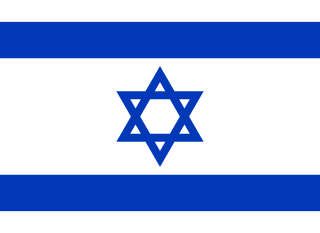Wheelchair basketball at the 1972 Summer Paralympics consisted of men's and women's team events.

Israel was the host nation of the 1968 Summer Paralympics in Tel Aviv. The Israeli team finished third in the medal table and won sixty-two medals: eighteen gold, twenty-one silver and twenty-three bronze. Over 750 athletes from 28 nations took part in the Games; the Israeli team included 53 athletes, 37 men and 15 women.
Ronald Arthur "Ron" Stein was an American athlete who competed at the inaugural Summer Paralympic Games held in Rome in 1960.

Also known as the 13th Stoke Mandeville Games, the 1964 Summer Paralympics was the 2nd Paralympic Games. Hosted in Tokyo, the games ran from 8 to 12 November. Australia won a total of 30 medals and finished fourth on the medal tally behind Italy (3rd), Great Britain (2nd) and the United States (1st). Australia competed in 6 of the 9 sports at the Games, winning medals in each of those sports, but was most successful in the pool, winning a majority of their medals in swimming events.
S5, SB4, SM5 are para-swimming classifications used for categorizing swimmers based on their level of disability. The class includes people with a moderate level of disability, and includes people with full use of their arms and hands, but limited to no use of their trunk and legs. It also includes people with coordination problems. A variety of disabilities are represented by this class including people with cerebral palsy. The class competes at the Paralympic Games.
S4, SB3, SM4 are para-swimming classifications used for categorising swimmers based on their level of disability. Swimmers in this class have coordination problems affecting all four of their limbs, or have movement in their arms, some trunk function and no leg function. Events this class can participate in include 50m and 100m Freestyle, 200m Freestyle, 50m Backstroke, 50m Butterfly, 50m Breaststroke, and 150m Individual Medley events. The class competes at the Paralympic Games.
S3, SB2, SM3 are para-swimming classifications used for categorising swimmers based on their level of disability. People in this class have some arm and hand function, but no use of their trunk and legs. They have severe disabilities in all their limbs. Swimmers in this class have a variety of different disabilities including quadriplegia from spinal cord injury, cerebral palsy and multiple amputations.

2 point player and 2.5 point player is a disability sport classification for wheelchair basketball. People in this class have partial trunk control when making forward motions. The class includes people with T8-L1 paraplegia, post-polio paralysis and amputations. People in this class handle the ball less than higher-point players. They have some stability issues on court, and may hold their wheel when trying to one hand grab rebounds.

4-point player is a disability sport classification for wheelchair basketball. Players in this class have normal trunk function but have a reduced level of functioning in one or both of their lower limbs. They may have difficulty with sideways movements. People in this class include ISOD classified A1, A2 and A3 players.
At the 1962 Commonwealth Paraplegic Games in Perth, Western Australia eighty nine athletes from nine countries competed in fourteen events.
Wheelchair basketball classification is the system that allows for even levels of competition on the court for wheelchair basketball based on functional mobility. The classifications for the sport are 1 point player, 2 point player, 3 point player, 4 point player and 4.5 point player, the greater the player's functional ability. Classification for the sport is set by the International Wheelchair Basketball Federation.
PR2 is a Paralympic rowing classification for people with trunk and arm function. The class includes people with spinal cord injuries, including people who have lesions from T10 to L4. This class has its origins in the P2 class, part of the original classification system for the sport developed in 1991.
F2, also T2 and SP2, is a wheelchair sport classification that corresponds to the neurological level C7. Historically, it was known as 1B Complete, 1A Incomplete. People in this class are often tetraplegics. Their impairment effects the use of their hands and lower arm, and they can use a wheelchair using their own power.
F3, also T3 and SP3, is a wheelchair sport classification that corresponds to the neurological level C8. Historically, it was known as 1C Complete, and 1B Incomplete. F3 sportspeople have functional issues related to the muscles in their throwing arm, though they have enough control over their fingers to grip a throwing implement normally. They have no functional trunk control.
F4, also T4 and SP4, is a wheelchair sport classification that corresponds to the neurological level T1- T7. Historically, it was known as 1C Incomplete, 2 Complete, or Upper 3 Complete. People in this class have normal upper limb function, and functional issues with muscles below the nipple line.
F5, also SP5, is a wheelchair sport classification that corresponds to the neurological level T8 - L1. Historically, it was known as Lower 3, or Upper 4. People in this class have some trunk function and good sitting balance. They have problems with hip function, that reduces their ability to rotate their spines.
F6, also SP6, is a wheelchair sport classification that corresponds to the neurological level L2 - L5. Historically, this class has been known as Lower 4, Upper 5. People in this class have good sitting balance, and good forward and backward movement of their trunk. They have some use of their thighs and can press their knees together.
F7, also SP7, is a wheelchair sport classification that corresponds to the neurological level S1- S2. Historically, it has been referred to as Lower 5. It is characterized by people having their lower limb muscles strength and function impacted. People in the SP7 class generally have good sitting balance and some trunk movement backwards and forwards. One side may be stronger than the other.
Wheelchair sport classification is a system designed to allow fair competition between people of different disabilities, and minimize the impact of a person's specific disability on the outcome of a competition. Wheelchair sports is associated with spinal cord injuries, and includes a number of different types of disabilities including paraplegia, quadriplegia, muscular dystrophy, post-polio syndrome and spina bifida. The disability must meet minimal body function impairment requirements. Wheelchair sport and sport for people with spinal cord injuries is often based on the location of lesions on the spinal cord and their association with physical disability and functionality.

Ayala Malchan-Katz is an Israeli Paralympic athlete. Between the years 1968-1988 she participated in six Paralympic competitions and won 13 medals, of which 5 were gold.






